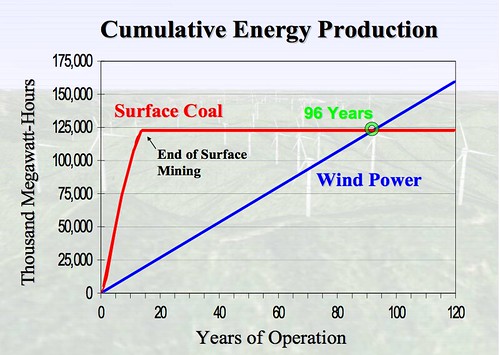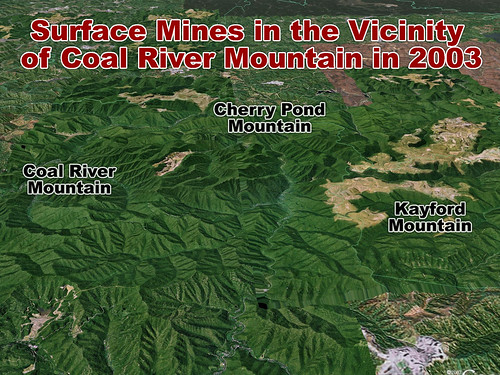Front Porch Blog
Appalachian coal is a dead end road. With coal production declining across the Appalachian region and prices nearly tripling since 2007, economists and energy analysts are increasingly saying that Appalachian coal is the wrong investment. In Appalachia alone, we’ve seen over 1 million acres of America’s oldest mountains destroyed forever, 1200 miles of headwater streams buried, and some of the highest poverty in the nation due to mountaintop removal mining. But, though we have lost much, the people of Appalachia are fighting back through organizing and advocacy from Charleston to Frankfort to Washington DC.
Coal River Mountain, located in Raleigh County, West Virginia is one of America’s Most Endangered Mountains. The communities surrounding the mountain have a rich and mixed history with America’s most polluting fossil fuel. As the name implies, many of the towns in the Coal River Valley grew up with the expansion of coal-mining. But, 150 years after coal-mining began in Appalachia, much of the central and southern Appalachians stand devastated by mining, and impoverished by coal companies hell-bent on keeping coal “cheap” at the expense of our land and people. The communities of the Coal River Valley are no different. Except for the people of the Coal River Valley – having seen the devastation that coal causes – have seen enough devastation to know that they need to take a new direction.
…
When you’re talking about Appalachia and coal, the word “battle” is not used lightly. From Matewan, to Harlan County, to Blair Mountain, violence and bloodshed are a very real part of our history. Now the inherently American legacy of the miners of Blair Mountain, courageous coalfield labor organizers, and the grassroots movement that led to surface mining laws in the 70s has reached a head. The Appalachian people have drawn our line in the sand. We stand here together to tell companies that would practice mountaintop removal to stop NOW. With popular support for clean energy, a better alternative, and literally everything at stake, the Appalachian people will win this battle of wind vs. fire.
The Battle for Coal River Mountain…
—
There are two potential futures for Coal River Mountain, WV and the people of the Coal River Valley.
Industrial Wind Power (top: wind potential) OR a Mountaintop Removal site (below: permit area in black)
Remember that mountaintop removal does the same thing to our economy that it does to the environment. Industrial wind development will create more jobs in the short AND long-term, as well as more energy in the long-term.


Coal companies have been to the neighborhood before, destroying several nearby mountains and leaving Raleigh County with an 18.5% poverty rate.

Coal River Mountain remains one of the most potentially productive spots in the surrounding coalfields for wind. You’ll notice many areas of class 4, 5, 6, and even class 7 wind potential here. This is a prime spot for wind power, and the future of Appalachia’s clean energy economy.
Coal River Mountain is approximately 20,550 acres in size, and 30 miles of if its ridges receive commercially viable wind speeds. There is room on Coal River Mountain to place 220 2.0MW wind turbines. Such a project would have the potential to produce 1.16 Million Megawatt-hours (MWh), enough to power 150,000 homes.
On Coal River Mountain, three surface-mining permits either approved, pending or in formation, together span 5,782 acres. As currently proposed, these “mines” would reduce wind potential to a point that a Coal River Mountain Wind Farm would become commercially unviable. The ensuing ecological devastation will be immense.
According to Coal River Mountain Watch:
These mines [on Coal River Mountain] will be at the heads of Horse Creek, Dry Creek, and Rock Creek, and will surround nearly the entire length of Sycamore Creek, considered to be the most pristine stream in the area. Communities are situated at the mouth of each of these streams.
But if coal companies have their way, they would blast Coal River Mountain right off the map. In fact, by overlaying permit data onto a topographical map in Google Earth, we can show you what the hypothetical coal company vision of Coal River Mountain would look like. On the left side of the image, you can see what a mountaintop removal site on Coal River Mountain would look potentially like.

There is so much at stake in Appalachia. Wind power is cheaper to extract. Wind power is cheaper to produce. Wind power has zero emissions. Wind power does not require us to tear down our mountains. Wind power will provide greater economic benefit. Wind power will provide more jobs. Wind power will provide more energy. The benefits are endless. Mountaintop removal has to end and it has to end now.
We all stand to gain by supporting the efforts of CRMW to save Coal River Mountain from mountaintop removal by setting up industrial wind energy.
If you can join the effort, and would rather see a windmill than a toxic mountaintop removal mine, please sign the Coal River Wind Petition and check out CoalRiverWind.org.
1. This week’s featured Blogs
Kate Sheppard over at Grist gives us On a Wind and a Prayer:
“This is the first alternative ever proposed that has a strong economic component, that has real benefits to it that could be brought to local communities,” said Rory McIlmoil, campaign coordinator for Coal River Wind. “The wind potential would be destroyed if they continue with the strip mining.”
The advocates from Coal River Wind are still open to allowing Massey to mine there as long as it’s at least 300 feet below the surface. They argue that the underground mine would actually create more jobs for local residents than an MTR site, which relies mostly on heavy machinery.
2. MTR Fact of the Week
According to Dr. Matthew Wasson of Appalachian Voices, energy produced by the Coal River Mountain Wind farm would be cheaper than energy produced by Duke Energy’s proposed “Cliffside” coal-fired power plant in North Carolina. So much for “cheap” coal.
Cliffside Energy Cost: $0.150 / kWh
Coal River Mountain Wind Energy Cost: $0.094 / kWh
3. Mountain Video
(Congratulations to the production team. This was one of the top 15 non-profit videos on YouTube last week!…)
Coal River Mountain, as featured on America’s Most Endangered Mountains
I also highly recommend watching these:
Rory McIlmoil and Lorelei Scarboro on this weeks’ Decision Makers:
Part I
Part II
Part III
4. Featured Activist
Lorelei Scarboro
 Lorelei Scarbro was born and raised in the Coal River Valley of West Virginia. She is the daughter and wife of coal miners, and has been active in the fight to save rural schools in West Virginia. She is now fighting for a clean just energy future for West Virginia and the Nation. Her writing, such as Winning with wind: Hope for Coal River Mountain in the Coal Valley news is spreading hope for people in the valley that they can save their economy and their mountains simultaneously by ending mountaintop removal and supporting industrial wind energy.
Lorelei Scarbro was born and raised in the Coal River Valley of West Virginia. She is the daughter and wife of coal miners, and has been active in the fight to save rural schools in West Virginia. She is now fighting for a clean just energy future for West Virginia and the Nation. Her writing, such as Winning with wind: Hope for Coal River Mountain in the Coal Valley news is spreading hope for people in the valley that they can save their economy and their mountains simultaneously by ending mountaintop removal and supporting industrial wind energy.
From an interview on Grist:
“My father was a coal miner. My grandfather was a coal miner. I have two brothers that are coal miners, my son-in-law is a coal miner,” says Scarbro, a life-long West Virginian and probably not someone you’d expect to be an outspoken opponent of coal. But Scarbro says, “I believe that the time for coal has come and gone, and I think we’re destroying our earth with fossil fuels. That’s the reason that we’re in the climate crisis that we’re in. I believe that we need to start transitioning.”
“It’s like living in a war zone when you have to sit in you home, you hear the blasting, and you breathe in the coal dust and you breathe in the rock dust,” says Scarbro. “To live with your house shaking every day, the foundation cracking, the windows rattling, it is really like living in a war zone.”
Learn more about Lorelei by watching this video on CoalRiverWind.org and this video on iLoveMountains.org.
5. Mountain Music
Check out Tim O Brien and Kathy Mattea original of “Walk the Way the Wind Blows” here
Walk the Way the Wind Blows
Also couldn’t help but put up a link to Bob D’s Subterranean Homesick Blues.
You don’t need a weatherman to know which way the wind blows!
Thats all for this week.
peace,
JW
PREVIOUS
NEXT
Related News

Leave a comment
Your email address will not be published. Required fields are marked *


